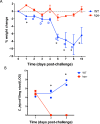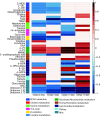A novel mouse model of Campylobacter jejuni enteropathy and diarrhea
- PMID: 29791507
- PMCID: PMC5988333
- DOI: 10.1371/journal.ppat.1007083
A novel mouse model of Campylobacter jejuni enteropathy and diarrhea
Abstract
Campylobacter infections are among the leading bacterial causes of diarrhea and of 'environmental enteropathy' (EE) and growth failure worldwide. However, the lack of an inexpensive small animal model of enteric disease with Campylobacter has been a major limitation for understanding its pathogenesis, interventions or vaccine development. We describe a robust standard mouse model that can exhibit reproducible bloody diarrhea or growth failure, depending on the zinc or protein deficient diet and on antibiotic alteration of normal microbiota prior to infection. Zinc deficiency and the use of antibiotics create a niche for Campylobacter infection to establish by narrowing the metabolic flexibility of these mice for pathogen clearance and by promoting intestinal and systemic inflammation. Several biomarkers and intestinal pathology in this model also mimic those seen in human disease. This model provides a novel tool to test specific hypotheses regarding disease pathogenesis as well as vaccine development that is currently in progress.
Conflict of interest statement
The authors have declared that no competing interests exist.
Figures









References
-
- Scallan E, Hoekstra RM, Mahon BE, Jones TF, Griffin PM. An assessment of the human health impact of seven leading foodborne pathogens in the United States using disability adjusted life years. Epidemiology and infection. 2015;143(13):2795–804. Epub 2015/01/31. doi: 10.1017/S0950268814003185 . - DOI - PMC - PubMed
-
- Kirk MD, Pires SM, Black RE, Caipo M, Crump JA, Devleesschauwer B, et al. World Health Organization Estimates of the Global and Regional Disease Burden of 22 Foodborne Bacterial, Protozoal, and Viral Diseases, 2010: A Data Synthesis. PLoS medicine. 2015;12(12):e1001921 Epub 2015/12/04. doi: 10.1371/journal.pmed.1001921 ; PubMed Central PMCID: PMC4668831. - DOI - PMC - PubMed
-
- Kotloff KL, Nataro JP, Blackwelder WC, Nasrin D, Farag TH, Panchalingam S, et al. Burden and aetiology of diarrhoeal disease in infants and young children in developing countries (the Global Enteric Multicenter Study, GEMS): a prospective, case-control study. Lancet. 2013;382(9888):209–22. Epub 2013/05/18. doi: 10.1016/S0140-6736(13)60844-2 . - DOI - PubMed
-
- Platts-Mills JA, Babji S, Bodhidatta L, Gratz J, Haque R, Havt A, et al. Pathogen-specific burdens of community diarrhoea in developing countries: a multisite birth cohort study (MAL-ED). The Lancet Global health. 2015;3(9):e564–75. Epub 2015/07/24. doi: 10.1016/S2214-109X(15)00151-5 . - DOI - PMC - PubMed
-
- Amour C, Gratz J, Mduma E, Svensen E, Rogawski ET, McGrath M, et al. Epidemiology and Impact of Campylobacter Infection in Children in 8 Low-Resource Settings: Results From the MAL-ED Study. Clin Infect Dis. 2016;63(9):1171–9. Epub 2016/08/10. doi: 10.1093/cid/ciw542 ; PubMed Central PMCID: PMC5064165. - DOI - PMC - PubMed
Publication types
MeSH terms
Substances
Grants and funding
LinkOut - more resources
Full Text Sources
Other Literature Sources
Medical

